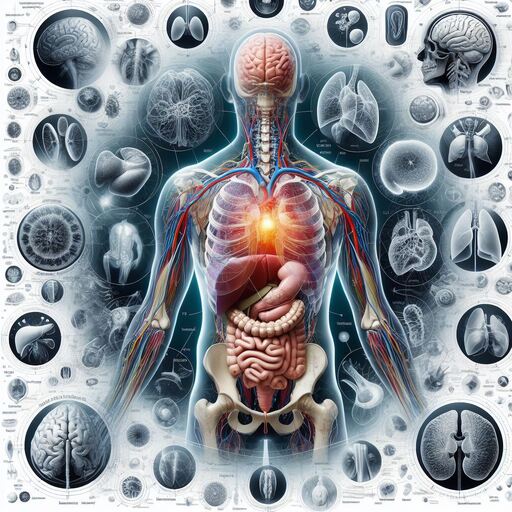Inside Out A Deep Dive into the Wonders of Anatomy
Inside Out A Deep Dive into the Wonders of Anatomy
Anatomy, the study of the structure and organization of living organisms, particularly the human body, unveils a world of extraordinary complexity and precision. It is a discipline that not only informs medical practice but also ignites curiosity about the intricate machinery that sustains life. In this article, we embark on a comprehensive exploration of human anatomy, from the microscopic level of cells to the integrated systems that define our existence.
Inside Out A Deep Dive into the Wonders of Anatomy
The Microscopic Marvels
At the foundation of human anatomy lies cellular biology—the study of cells, the basic units of life. Cells are remarkably diverse in structure and function, adapted to perform specialized tasks that collectively contribute to the functioning of tissues and organs. Understanding cellular anatomy provides insights into how living organisms are organized and how they carry out essential processes such as growth, repair, and metabolism.
One of the most fascinating aspects of cellular anatomy is the diversity of cell types. From neurons that transmit electrical signals in the nervous system to red blood cells that transport oxygen throughout the body, each cell type is equipped with specific structures that enable it to perform its designated function. For instance, muscle cells contain abundant contractile proteins that facilitate movement, while glandular cells possess specialized machinery for producing and secreting substances.
The Skeletal Framework
Moving beyond individual cells, the skeletal system stands as the architectural framework of the human body. Comprising bones, cartilage, ligaments, and tendons, the skeleton provides support, protection, and mobility. The intricate arrangement of bones allows for a remarkable range of movements, from the nimble dexterity of the fingers to the powerful strides of the legs.
The skeletal system also plays a critical role in hematopoiesis—the production of blood cells within the bone marrow. Red bone marrow serves as a factory for red blood cells, white blood cells, and platelets, essential components of the circulatory and immune systems. Understanding the structure and function of bones is crucial for diagnosing and treating conditions such as fractures, osteoporosis, and arthritis.
Inside Out A Deep Dive into the Wonders of Anatomy
The Symphony of Muscles
Muscles are the engines of movement, transforming electrical impulses into mechanical force. The muscular system consists of three main types of muscle tissue: skeletal, cardiac, and smooth muscles. Skeletal muscles, attached to bones via tendons, enable voluntary movements such as walking, running, and grasping objects.
Meanwhile, cardiac muscles form the walls of the heart, contracting rhythmically to pump blood throughout the body. The unique properties of cardiac muscles allow for coordinated contractions that maintain the heart’s pumping efficiency. In contrast, smooth muscles, found in the walls of organs and blood vessels, facilitate involuntary movements such as peristalsis (wave-like contractions) in the digestive tract.
The Command Center: Nervous System
The nervous system serves as the command center of the body, orchestrating intricate processes and enabling communication between different parts of the body. Comprising the brain, spinal cord, and peripheral nerves, the nervous system integrates sensory information, coordinates motor responses, and regulates bodily functions.
Neurons, the specialized cells of the nervous system, possess unique structures such as dendrites (receiving ends) and axons (transmitting ends) that allow for rapid communication via electrical and chemical signals. Understanding neuroanatomy is essential for diagnosing and treating neurological disorders, from strokes to neurodegenerative diseases like Alzheimer’s and Parkinson’s.
Exploring Interconnections
Anatomy extends beyond isolated systems, revealing the interconnectedness of bodily functions. For instance, the cardiovascular system—comprising the heart, blood vessels, and blood—distributes oxygen, nutrients, and hormones throughout the body while removing metabolic waste products. This system collaborates with the respiratory system, which provides oxygen and eliminates carbon dioxide, to maintain homeostasis.
Moreover, the endocrine system—consisting of glands that secrete hormones—regulates metabolism, growth, and reproduction. Hormones act as chemical messengers that influence cellular activities across multiple organ systems, highlighting the integrative nature of human anatomy.
In Conclusion
Delving into the wonders of human anatomy unveils a tapestry of interconnected structures and functions that define life itself. From the intricate organization of cells to the coordinated actions of organ systems, anatomy represents the blueprint of biological existence. By studying anatomy, we gain not only a deeper understanding of ourselves but also profound insights that inform medical practice, inspire scientific inquiry, and foster appreciation for the marvels of the natural world.
Inside Out A Deep Dive into the Wonders of Anatomy

